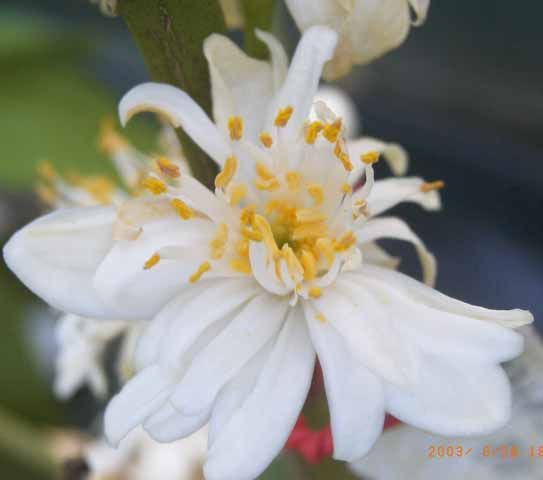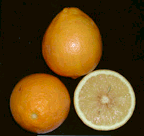|
|||||||||
Select any of 50 available languages! |
|||||||||
Citrus oils |
 |
Extraction and composition |  |
| Users | ||
| Oil names | ||
| Table lay-out and abbreviations | ||
| Table of citrus oils | ||
| Bouquetier
de Nice à fleurs doubles © Petr Broža |
Citrus
hystrix, leaves © Citrus Clonal Protection Program |
|
Extraction and composition
Users
Confusion in the names
Table lay-out and abbreviations The
table below is a compilation of the most common citrus oils.
The
titles bergaptenless, monoterpeneless and terpeneless refer to oils
that have these substances chemically removed as they can be harmful if
ingested in large quantities. These oils are used in food and
alcohol products.
|
||||||||||||||
| There is a more detailed description of Neroli, Bigarade and Petitgrain oils at the bottom of the table. | ||||||||||||||
This table is
optimised for 1024 x 768 resolution. Smaller resolutions may cause the
lines to overlap.
|
| C I T R U S O I L S | |||||
| Plant Botanical name |
Fruit Link to description |
Oil Trade name |
Raw
material Part of the plant used |
Process |
Main
users See abbreviations below |
| Citrus aurantiifolia | Lime | Lime Lime |
Outer peel of medium ripe fruit Crushed fruit |
Cold expression Steam distillation |
ARO, PER COS, FOO |
| Citrus aurantium | Sour orange | Neroli Citrus aurantium absolute Neroli bigarade Neroli petitgrain |
Flowers Flowers Outer peel of medium ripe fruit Leaves and twigs |
Steam distillation Solvent extraction Cold expression Steam distillation |
ARO, FOO, PER ARO, PER ARO, FOO ARO, FOO |
| Citrus aurantium var. bigaradia |
Bittersweet orange | Bigarade Bigarade terpeneless Petitgrain Petitgrain terpeneless |
Outer peel of nearly ripe fruit Outer peel Leaves and twigs Leaves and twigs |
Cold expression Cold expression Steam distillation Steam distillation |
ARO, PHA ALC, FOO ARO FOO |
Citrus aurantium 'Bouquetier' |
Perfumery varieties |
Neroli Citrus aurantium absolute |
Flowers Flowers |
Steam distillation Solvent extraction |
PER, ARO PER, ARO |
| Citrus aurantium ssp. bergamia |
Bergamot | Bergamot Bergamot bergaptenless Bergamot petitgrain Bergamot |
Outer peel of medium ripe fruit Outer peel of medium ripe fruit Leaves, twigs and unripe peel Crushed fruit |
Cold expression Cold expression Steam distillation Steam distillation |
ARO, PER ALC, FOO PER, Eau de Cologne CHE, COS |
| Citrus hystrix | Kaffir lime | Combava Combava petitgrain |
Nearly ripe peel, pulp and leaves Leaves and twigs |
Steam distillation Steam distillation |
COS, FOO COS |
Citrus limetta |
Limetta |
Limetta |
Outer peel |
Cold expression |
|
| Citrus limon | Lemon | Lemon Cedro oil Lemon petitgrain |
Outer peel of fresh ripe fruit Bergaptenless and terpeneless Leaves, twigs and small raw fruit |
Cold expression Cold expression Steam distillation |
ARO, CHE, COS, PER, PHA ALC, FOO CHE, COS, PER, PHA |
| Citrus medica | Citron | Cedrat Cedrat Cédrat petitgrain |
Flowers Peel Leaves and twigs |
Steam distillation Cold expression Steam distillation |
PER ARO, FOO, COS FOO, PER |
| Citrus paradisi | Grapefruit | Grapefruit Grapef.monoterpeneless |
Outer peel of fresh ripe fruit Peel |
Cold expression C. expr./distillation |
ARO ALC, FOO, "Tonic"-waters |
| Citrus reticulata | Mandarin | Mandarin Mandarin terpeneless Mandarin petitgrain |
Outer peel of fresh ripe fruit Outer peel Leaves and twigs |
Cold expression Cold expression Steam distillation |
ARO, PER ALC, FOO COS, PER |
| Citrus sinensis | Sweet orange | Sweet orange Sweet orange Neroli Portugal |
Outer peel of ripe fruit Crushed fruit Flowers |
Cold expression Steam distillation Steam distillation |
ARO, COS, PER CHE PER |
Main users: ALC alcohol industry, ARO aromatherapy, CHE chemical industry, COS cosmetics, FOO food industry, PHA pharmaceutical industry, PER perfume industry. |
|||||
|
Neroli oil is usually made from buds and flowers of sour orange or sweet orange. The finest Neroli is made by slow cold expression. Usually Neroli is made by steam distillation. Genuine orange-flower water is a by-product of this steam distillation. Neroli oil is always expensive. If you get cheap Neroli it is either adulterated with cheaper oils or synthetic. The most expensive Neroli comes from the perfumery varieties, which are grown only for Neroli oil. Bigarade is made from the outer part of the peel of usually medium ripe fruit by cold expression. Petitgrain oil can have varying compositions according to the fruit used and the purpose for which the oil is made. Most often it is made of fresh leaves and twigs of the same year. Sometimes whole small raw fruit or peel of raw fruit is added. Petitgrain is always made by steam distillation. In addition to the oils above, less expensive oils are made by steam distillation from the pulp and peel left over from industrial juice extraction. These oils are often sold by the name of the fruit (lime oil, grapefruit oil) but the compounds, which can be harmful when ingested (bergapten, some terpenes), have been chemically removed. These oils are used by the food industry to flavour soft drinks, chewing gum, sweets, marmalades, confectioneries and citrus liqueurs. |
|||||

|
|
Page up-dated 20 November 2009
Back to top of page









